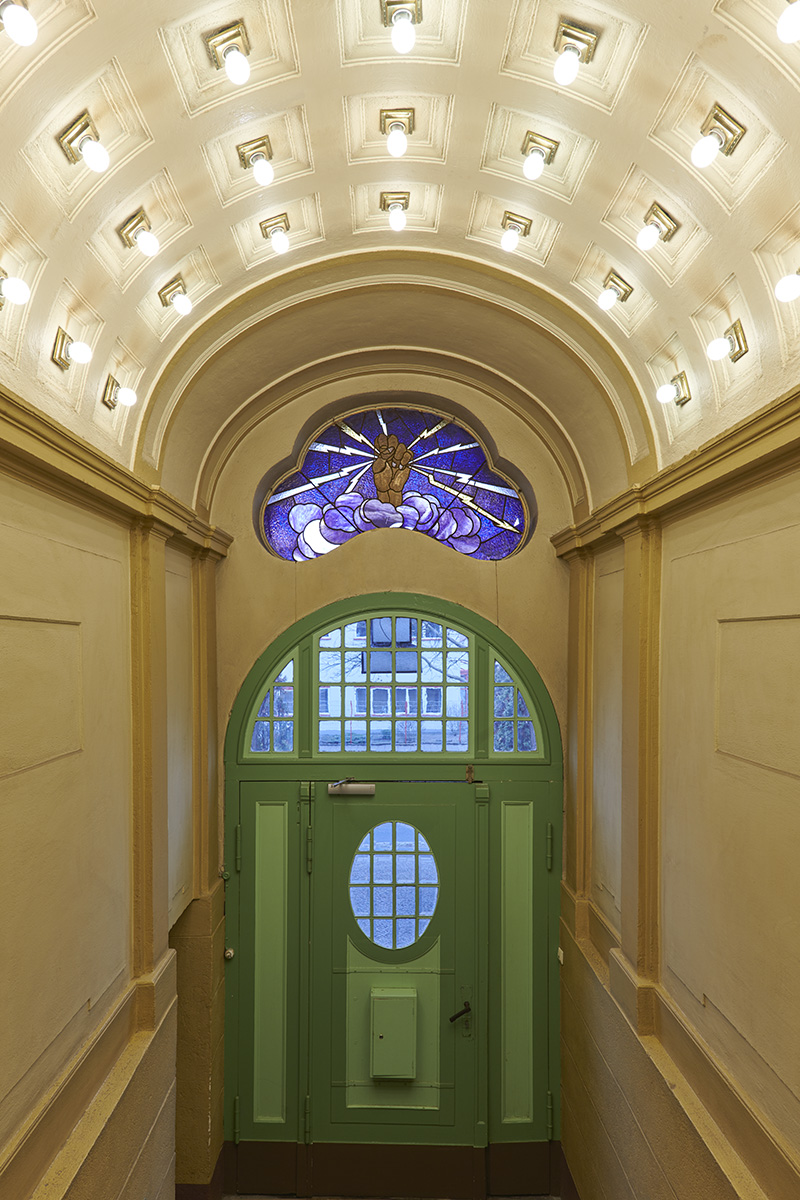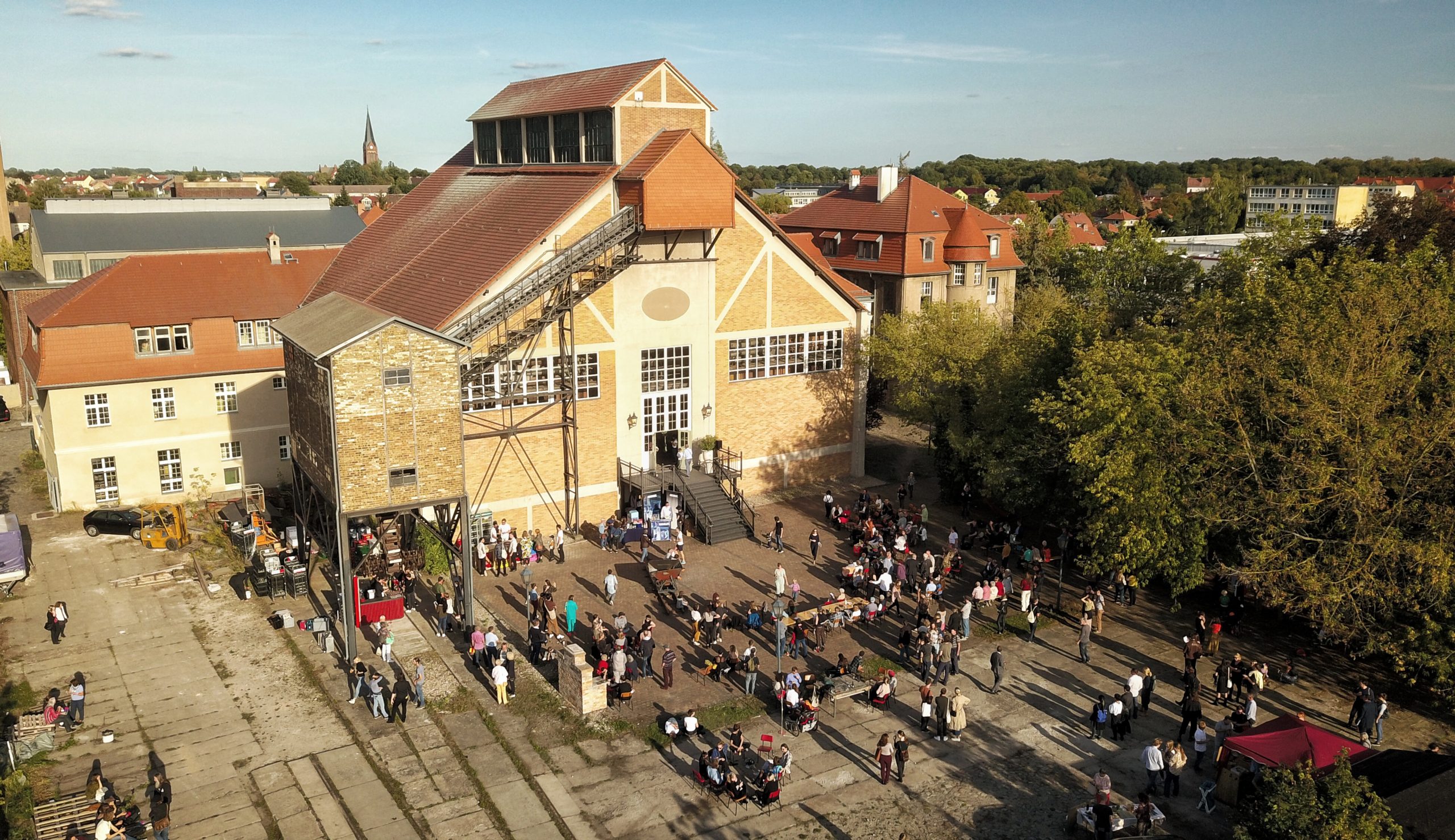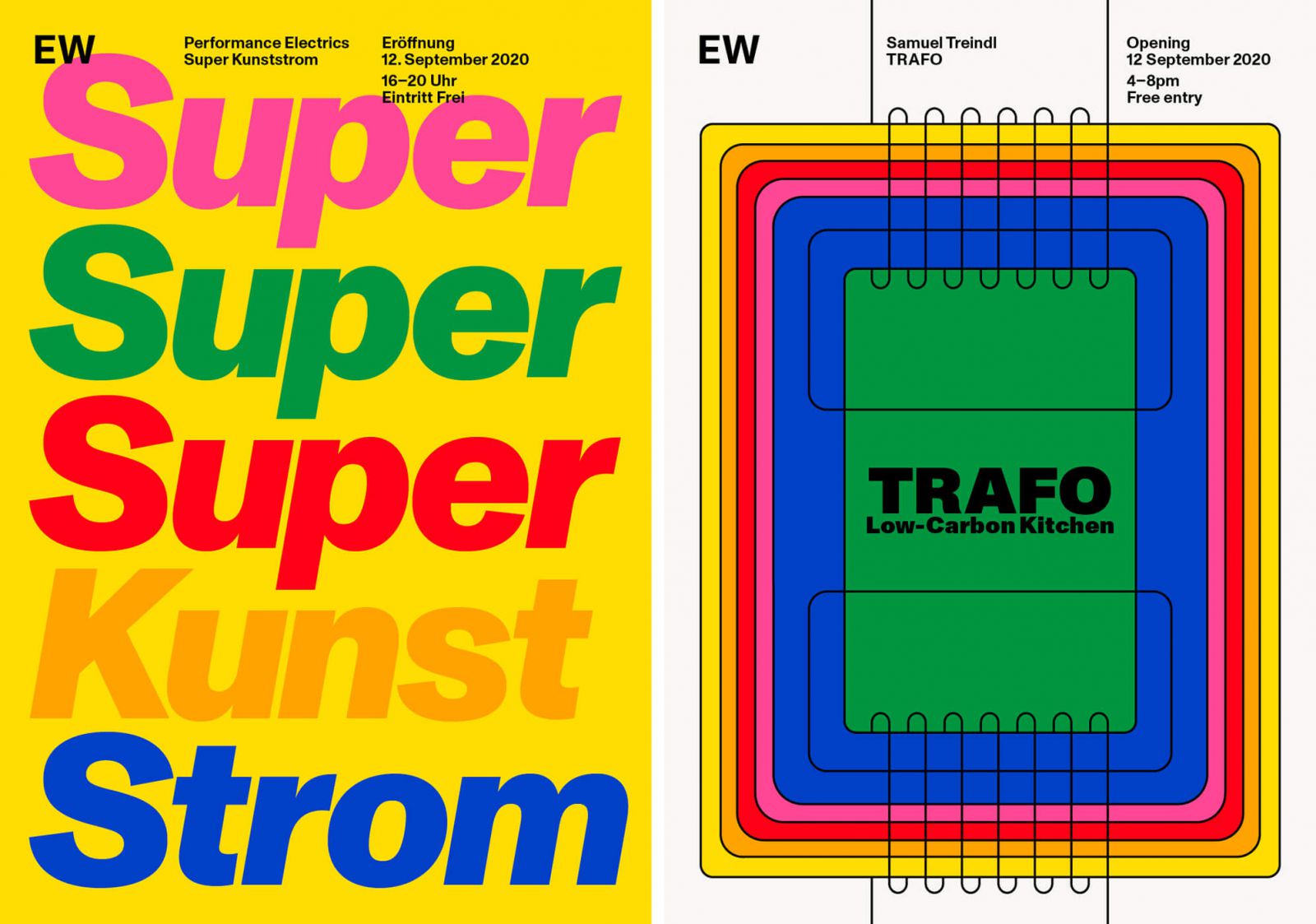by Judith Vallette // Aug. 27, 2020
With sustainability mission statements and visions becoming increasingly important in all sectors, E-WERK Luckenwalde demonstrates what it looks like to make a positive impact while going against structures of excess waste production. We had the opportunity to tour E-WERK’s recently-acquired facilities, a transformed coal power plant that now generates renewable electricity, feeding into the national grid and available for purchase in institutions and homes. This energy has been labeled “Kunststrom,” literally meaning art power: a fitting title, as E-WERK runs art exhibitions and programming using their self-sufficient power supply. There are art studios available for rent, spaces for planned ceramic and wood workshops, volunteers supplying their skills and knowledge in return for space and the opportunity to take creative charge. The two artistic directors, Helen Turner and Pablo Wendel, have managed to instill core symbiotic values of community and sustainability in the short time since moving in and establishing the art center, proving that these kinds of seemingly utopian ideals are within reach. Turner and Wendel spoke to us about the process behind E-WERK’s foundation, how they enthusiastically steered away from consumerist energy models, how the pandemic has affected their work and what they have planned for their reopening on September 12th.

E-WERK Luckenwalde entrance, 2019 // Copyright of E-WERK Luckenwalde and Ben Westoby
Judith Vallette: How has the pandemic affected or not affected this working model of sustainability, given your emphasis on the local, seasonal, etc.?
Pablo Wendel: I think a couple of years ago I would have just had a really hard time right now because I had so many dependent situations, like paying rent, paying for energy or having so many side costs. After setting up the whole thing just a year and a half ago, we have the first crisis test. But, it’s basically a reality test, and it works. I can really say I’m so happy we invested in this and we went in the direction of self-sufficiency. We made a lot of changes and are actually quite stable compared to many other art institutions and artists, as well. Of course, we share the same struggle regarding the audience we can’t have, but we can still keep running because we have this energy income. We have no outgoing costs anymore, the house pays itself off: the energy is sustainable, self-sufficient. And that makes a big difference.
Helen Turner: We were able to stop. We were quite fortunate actually because I saw how other creative institutions and the industry generally reacted and it was to shift to digital because there was this necessity to produce something, in order to keep your employees in work, in order to survive. It’s this whole ecosystem that’s reliant on excessive programming. We had a luxurious moment where we could take a break and think about exactly what we are doing and how to do it better. We used this moment—which was sad and disappointing in many ways, having to postpone our programme—to really take a moment and think about how we can rebuild the world after the pandemic and how we can change some of these ingrained systems that are no longer working. This is why we didn’t shift to digital, we just spent the last three months making a five-year plan for the programme, which we would never have had the opportunity to do otherwise. It is also a hugely devastating pandemic: I’m not being an opportunist about it but, it’s important to stay positive.

E-WERK Luckenwalde aerial photograph, 2019 // Copyright of E-WERK Luckenwalde and Tim Haber
JV: Tell us about Kunststrom – what is it? Do you see opportunities for Kunststrom to transform other currently unsustainable structures (and do you have future plans for extension)?
PW: A basic intro to Kunststrom: it is essentially electricity produced with art, so that can be sculptures, performances, installations or it can even be an old transformed power plant, like this coal power plant. It’s about trying to use the resources that normally provide energy in an artistic way. You can decide to do it in a technical way—economically, like how all the companies do it—and you end up having a very pragmatic functioning powerplant or wind generator. Or, you could also do it in a way that you create an aesthetic experience, and then you end up maybe losing a little bit of the energy but you get something, like a piece of art or aesthetic experience. Then you have a different sort of energy coming out of this. At some point, you question what sort of energy it is: it is more than just sustainable, it is more than just technically produced, it is made out of art or with the art. So you have “Kunststrom”, which literally means art electricity, art power. This is one aspect, but the other aspect is the way we put it in the national grid, which everyone relies on, is connected to and dependent on. Kunststrom is like a little homeopathic dose into this huge ocean of energy everywhere. Since we are a non-profit organization that means all the money we raise or we make with this energy sale goes 100 percent back into new Kunststrom productions or development of exhibitions. So when someone takes energy from us, they support a cultural institution. And that’s quite an interesting model compared to an economic model where it’s just about raising more money and profit.
In the beginning, it was sculptures, projects but it became more and more a model for other institutions, an exchange. You realize the art process goes really deep in society: it connects researchers with social workers. It becomes transdisciplinary. It becomes something that is really valuable, an educational programme. We are now able to consult other art institutions about changing their energy concept or their economic model into something different.

E-WERK Luckenwalde
JV: What was your curatorial process for the concept behind your ongoing conversation series ‘The Artist as Consultant’ and how did you decide which artists to invite?
HT: ‘The Artist as Consultant’ was born out of this moment, taking pause. As a curator, artists have always been my best consultants for whatever I’ve wanted to do. We wanted to look at how to construct a programme or how to change the institution to actually benefit the artists because the artists are the driving force of any kind of creative process. I really believe they should be the heart of all kinds of cultural institutions. I really wanted to give artists this platform or this voice for them to say how we can disrupt these ingrained systemic policies that aren’t working anymore, how we can change these outmoded practices that are inherently subjugating some people and exploiting some groups. The idea was to invite artists from different backgrounds, all over Europe as well—so it wasn’t just Germany focused or London focused—to get their opinions.
For instance, Harold Offeh and Michelle Gamaker spoke about the future of art education, but they particularly focused on the voice of people of colour in education. I was shocked in that first episode. Thinking about it, I had never had a person of colour as a teacher, and I am 34. I’ve done a Bachelor’s degree, I’ve done a Master’s degree, and I find that really terrible. ‘The Artist as Consultant’ was really thinking politically about how artists can help to catalyze different ideas and provoke change. Also, I am very inspired by the Artist Placement Group, which was a group practicing in the 80s and 90s that put artists in the industry and really championed artists’ ability to enact real social and political change. I really believe that art and culture can do that, so it was just about providing a platform to enable that. The artists were chosen from lots of different international backgrounds and also artists that are emerging as well as established. There is a new episode that came out this week, which is between Isabel Lewis and Lucia Pietroiusti about sensory innovation. This is so interesting because they are talking about the difference between soft knowledge and hard knowledge, with soft knowledge being kind of like arts or kind of like physical experience. Lewis is a trained dancer so she talks about how she learns through dance and how that is not recognized in normal society as education or as knowledge, and how we can change that and how we can champion those different knowledge structures that aren’t perhaps given as much value as other things like the hard sciences or economics.
Everybody has had this moment to think about how we can improve, how we can rebuild the world and it was a conversation series to specifically talk about that. I’m not saying we will have all the answers but, it will provoke questions, which is what good art should do. Anna Gritz, curator of KW in Berlin and Peles Empire will be talking about parenting in the arts, something close to my heart. It’s incredibly difficult to be a parent and work. It is possible, though, but we need to think about how institutions or cultural policy can be adapted to support those parents better.

Courtesy of E-WERK Luckenwalde, design: Lorenz Klingebiel
JV: On your two upcoming commissioned works for September: TRAFO, a low carbon kitchen and bar aiming to center discussions on how food has many eco-political implications and ‘Super Kunststrom’, a sculpture offering free electricity to the public. What can we expect from these, as well as the workshop programme ‘Essen für Alle’?
HT: ‘TRAFO’ will be opening to the public as a kitchen and will be serving low carbon dishes mainly sourced from the garden and using Kunststrom biogas, but also from Kunststrom generated electricity, so all renewable energy. ‘Essen für Alle’ is a workshop for which we worked together with Katherine Thomson. We curated a programme that thinks about alternative cooking methods and how we can work with less. A big ambition of mine as a curator is how to create an ambitious international programme and not be reductive, and that’s the same with the limitations of biogas or cooking: how can we still create really delicious, exciting, experimental food with a very limited supply of gas? It must be possible, and I think that’s what artists are really good at, working with limitations. The kitchen will be open, and visitors will also be able to take a bath on the roof as a kind of tribute to living in former East Germany and the FKK culture. Then ‘Super Kunststrom’, Performance Electrics’ latest commission, will be providing free electricity for e-bikes, as well. The ‘Super Kunststrom’ are actually defunct 1980s petrol stations. It’s sort of the same gesture as transforming the coal power station, transforming the petrol into renewable by using the same infrastructure.
PW: Yes, the idea is to give energy for free to everyone, to the public, and its basically an access point, which is like an icon of the fuel-dependent time period we had and still have. It is a fuel station, a pump station itself, which gave fuel to the people for 400 years, and made everyone addicted to it. We can’t imagine a world without this fuel coming out of there: it’s a very fuel-based society. We used this as a symbol and transformed it into something that is sustainable and cultural. It gives free Kunststrom away: so you can go to the Kunststrom station and instead of filling your car, there are sockets there to plug in your phone, your computer, your car or electric transport vehicles. I think it’s quite a nice gesture and makes people experience the idea that things can be free as well, because we learn that we always have to pay for everything. It also goes against the structure of the energy companies, which is very dominated by a few companies, meaning that people give all their money to just a few companies. It could be different, it could be that all the money goes to culture or something else, like we do it, or it could be for free. There are many ways to think of it. I think ‘Super Kunststrom’ gives a little push toward seeing it differently and trying to stop fossil energy.
HT: For the opening, people will arrive and will see ‘Super Kunststrom’ and will be able to charge their bike, and also be able to pedal the bicycle and generate their own Kunststrom so they can charge their phone. Then they’ll come in and see TRAFO and there will be food and free drinks by Campari. There will also be a short trailer of ‘The Artist as Consultant’ on display. Then we’ll have live jazz on the roof of TRAFO, presented by one of the studio artists. A very exciting day!
Exhibition Info
E-WERK LUCKENWALDE
Opening Event: Saturday, Sept. 12, 2020; 4-8pm
Rudolf-Breitscheid-Straße 73, 14943 Luckenwalde, click here for map

























